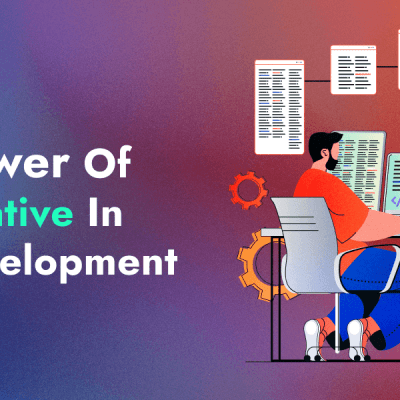[vc_row][vc_column][blog_single_full_content]We have often heard, our future is in our own hands. Well, in this case, the future is actually in our hands in the form of mobile apps. Mobile app development is one such sector that is growing at a fast pace and going to continue in the near future as well. Apps are here since a long time but, you can’t serve similar things to the audience for years, there has to be updates and upgrades to keep them hooked with your app. There are currently 2.8 Million apps in the Google Play Store and 2.1 Million apps in the Apple App Store.
Now, if you are looking to develop one of your own, you will have to keep an eye on future trends and integrate them into your mobile application development.
1) IoT
We can say that any word with a prefix smart can be connected to IoT. There are a smartwatch, smartphone, smartTV, cameras, home, camera, thermostats, smoke alarm, doorbells, and plenty of other smart things. Every such thing requires IoT integration. The use of such products is increasing with each passing day which asks for mobile app design and development company to develop IoT apps. The trend of Amazon Echo, Google Home, and Apple HomePod are on a heavy rise and we will be seeing more of these in the future. As per Gartner’s report, by the year 2020, around 26 Million devices will be connected with IoT.
2) Progressive Web Apps
These apps are feature-rich yet extremely light weighted exactly what users are looking for. Google compared 1000 top mobile apps and top 1000 web apps. The reports were quite a surprise. Mobile app received 4 Million active monthly visitors whereas the web apps received 11.4 Million, active monthly visitors. The engagement of Progressive web apps (PWA) is quite higher than that of native mobile phone app development. PWA is highly responsive, lightweight, secure, and unaffected with the network flaws. Also, it has the same look and feel of the native app. Popular apps like Twitter Lite, Pinterest, and Bookmyshow have already shifted to PWA and experienced an increase in the number of users and conversion rates and a decrease in the bounce rate.
3) AI/ML Artificial Intelligence and Machine Learning
AI and machine learning are becoming integral parts of the future of mobile app development. To provide the user with a personalized experience, they must integrate AI in their mobile app development process. Take an example of one of the trending apps, Netflix. It uses artificial intelligence to get algorithms of user behavior to provide them personalized suggestions. Tinder has integrated machine learning to increase the user’s chance to find a match. Even Google maps are trying to make the parking process easy to avail options to choose a parking spot, all thanks to machine learning.
4) AR/VR Augmented Reality and Virtual Reality
AR and VR are not just the present but, also the future of mobile app design and development. Gaming has entirely altered with the advent of AR and VR it all started with Pokemon Go and there is no stop after that. AR and VR are not just limited to gaming apps but are integrated into several other things as well. Say, for example, Google translate. It allows the users to launch a camera mode within an app and take a picture of the text you don’t understand and translate the text in the language you understand. Not, just that real estate, eCommerce, furniture and plenty other industries have ingrained the usage of AR and VR.
5) Cloud-based apps
There are a plethora of benefits attached to cloud technology. It cuts down on the hosting and operational cost, provides scalable infrastructure, seamless performance, expandable storage, and increased productivity. Such mobile app development will reduce the load from the internal storage and fetch the data from the cloud itself. This is why cloud-based apps are a considerate part of the future of mobile applications. Apps like Dropbox, Box, and Google Drive are becoming highly popular these days.
6) Blockchain
It is not just the technology behind cryptocurrency but has much more to it. It is like a digital account book to record the transactions and create transparency eliminating the chances of fraud and other malpractices. The integration of blockchain is not just limited to financial transactions but can be used in various industries. It can be integrated into every industry with a need for quality control, tracking items, and managing security levels. Exchanging markets like eCommerce, digital wallets, smart contracts, and tracking have already implemented blockchain into their business.
7) Chatbots
Back in the date chatbots were only used in messaging services like Skype, Slack, and Facebook. It is basically a self-service framework so that the users can receive quick responses to their queries. With the advancement in technology, it has been easy to integrate chatbots in mobile apps and enrich the user experience. Chatbots provides conversational experience to the app and the users which are great to engage and retain the users.
8) Wearables
Wearables have traveled from being a luxury item to a necessity. With people fitness freaks and focusing highly on personal health, manufacturing and sales have experienced a huge upward shift. These are a great way to track your progress and get updates on the heart rate, blood pressure, calories, and several other things. It helps in managing a lifestyle with reminders on water intake and sleep patterns. Every wearable device needs an app to function. Which is what makes them the future of mobile app development.
Conclusion
If you are intertwined with the development and intend to stay ahead of your competitors, knowing the future possibilities is important. Learn the above trends if don’t already know and integrate them into your development at the earliest. Each trend is already being used in the present and will continue to rule the app development industry in the future.[/blog_single_full_content][/vc_column][/vc_row]






